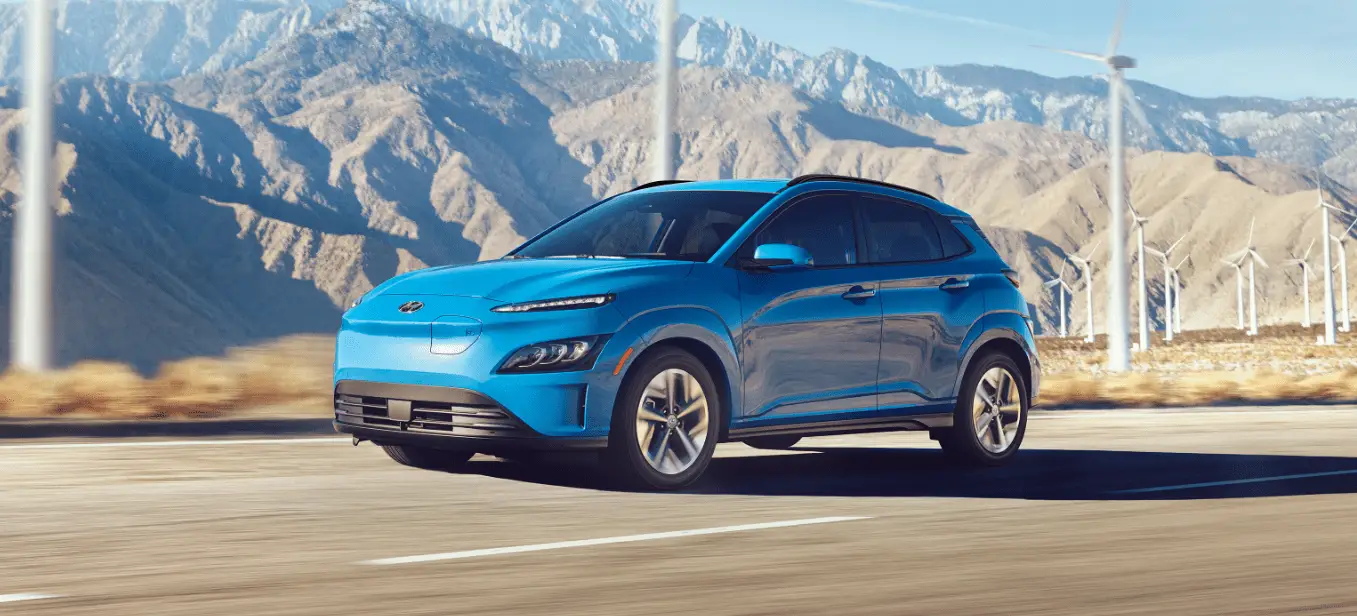Hyundai Kona-EV 2023 Braking System
The 2023 Hyundai Kona Electric Vehicle (EV) has an advanced and effective stopping system that shows how far modern car technology has come. At its heart, the Kona EV uses regenerative braking, which is a cutting-edge feature that not only makes the car more efficient but also makes driving more environmentally friendly. When the driver lets off the gas pedal, this clever regenerative system catches the kinetic energy and turns it into electrical energy. This recharges the car’s battery and increases its range. In addition to this eco-friendly improvement, the Kona EV still has the comforting feature of hydraulic brakes, which make it easy to stop when needed. This method to braking gives you great control and safety, and it also reduces the wear on traditional brake pads, which could make them last longer. With customizable regenerative settings and advanced safety features like automatic emergency braking, the 2023 Hyundai Kona EV’s braking system sets a high bar for both efficiency and safety, making it a better vehicle to drive overall.
2023 Hyundai Elantra Specs, Price, Features, Milage (Brochure)
Braking System
Power Brakes
Your vehicle has power-assisted brakes that adjust automatically through normal usage. In the event of a vehicle power failure, the power assist for the brakes will not work. You can still stop your vehicle, but it will require greater force and increased pedal travel than normal. The stopping distance, however, will be longer than with power brakes.
Information
- When the brake pedal is depressed under certain driving conditions
or weather conditions, you may temporarily hear a noise. This is normal and does not indicate a problem with your brakes. - While driving on a road with deicing chemicals, brake noise or abnormal tire wear may occur due to deicing chemicals. In safe traffic conditions, additionally, apply the brakes to remove deicing chemicals on the brake discs and pads.
WARNING
- Take the following precautions:
Do not drive with your foot resting on the brake pedal. This will create abnormally high brake temperatures, excessive brake lining and pad wear, and increased stopping distances. - When descending a long or steep hill, shift to a lower gear and avoid continuous application of the brakes. Applying the brakes continuously will cause the brakes to overheat and could result in a temporary loss of braking performance.
- Wet brakes may impair the vehicle’s ability to safely slow down; the vehicle may also pull to one side when the brakes are applied. Applying the brakes lightly will indicate whether they have been affected in this way. Always test your brakes in this fashion after driving through deep water. To dry the brakes, lightly tap the brake pedal to heat up the brakes while maintaining a safe forward speed until brake performance returns to normal. Avoid driving at high speeds until the brakes function correctly.
NOTICE
- Do not continue depressing the brake pedal if the ” ” indicator is OFF. The battery may be discharged.
- Noise and vibration generated during braking is normal.
- Under normal operation, electric brake pump noise and motor vibration may occur temporarily in the below cases.
- When the pedal is depressed suddenly.
- When the pedal is repeatedly depressed in short intervals.
- When the ABS function is activated while braking.
Disc Brakes Wear Indicator
When your brake pads are worn and new pads are required, you will hear a high-pitched warning sound from your front or rear brakes. You may hear this sound come and go or it may occur whenever you depress the brake pedal.
NOTICE
To avoid costly brake repairs, do not continue to drive with worn brake pads.
Information
Always replace brake pads as complete front or rear axle sets.
Electronic Parking Brake (EPB)
Applying the parking brake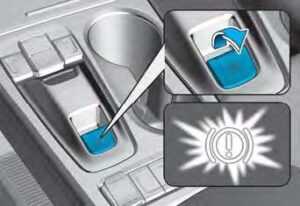
To apply EPB (Electronic Parking Brake):
- Depress the brake pedal.
- Pull up the EPB switch.
Make sure the Parking Brake Warning Light comes on. With the Auto Hold feature enabled, the EPB is automatically applied when the vehicle is shut off.
However, if Auto Hold is OFF when the vehicle is turned off, the EPB will not be applied.
WARNING
To reduce the risk of SERIOUS INJURY or DEATH, do not operate the EPB while the vehicle is moving except in an emergency situation. It could damage the brake system and lead to an accident.
Releasing the parking brake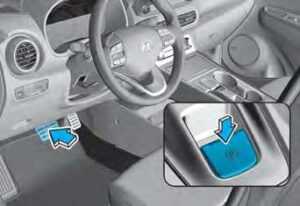
To release EPB (Electronic Parking Brake):
- Place the START/STOP button in the ON position.
- Depress the brake pedal.
- Press the EPB switch.
Make sure the Parking Brake Warning Light goes off.
To release EPB (Electronic Parking Brake) automatically:
- Shift lever in P (Park)
With the vehicle in the ready ( ) mode, depress the brake pedal and shift out of P (Park) to R (Reverse) or D (Drive). - Shift lever in N (Neutral)
With the vehicle in the ready ( ) mode, depress the brake pedal and shift out of N (Neutral) to R (Reverse) or D (Drive).
Satisfy the following conditions
- Ensure seat belts are fastened and the doors, hood and liftgate are closed.
- With the vehicle in the ready ( ) mode, depress the brake pedal and shift out of P (Park) to R (Reverse), D (Drive).
- Depress the accelerator pedal.
Make sure the Parking Brake Warning Light goes off.
Information
- For your safety, you can engage EPB even though the START/STOP button is in the OFF position (only if battery
power is available), but you cannot release it. - For your safety, depress the brake pedal and release the parking brake manually with the EPB switch when you drive downhill or when backing up the vehicle.
NOTICE
- If the parking brake warning light is still on even though the EPB has been released, have the system checked by an authorized HYUNDAI dealer.
- Do not drive your vehicle with EPB applied. It may cause excessive brake pad and brake rotor wear.
EPB (Electronic Parking Brake) may be automatically applied when:
- Requested by other systems.
- The driver turns the vehicle off while Auto Hold is operating.
Warning messages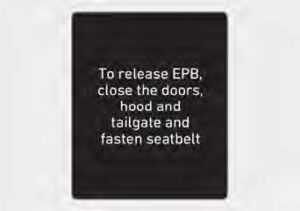
To release EPB, close the doors, hood and liftgate and fasten the seatbelt
A warning will sound and a message will appear in the following conditions:
- If you try to drive with the EPB applied.
- If the driver’s seatbelt is not fastened, and you try to release EPB.
- If the driver’s door is opened, and you try to release EPB.
- If the hood is opened with the gear in D (Drive) and you try to release EPB.
- If the liftgate is opened with the gear in R (Reverse) and you try to release EPB.
- If there is a problem with the vehicle.
WARNING
- To prevent unintentional movement when stopped and leaving the vehicle, do not use the P (Park) position in place of the parking brake. Set the parking brake and make sure the vehicle is securely positioned in P (Park).
- Never allow anyone who is unfamiliar with the vehicle to touch the parking brake. If the parking brake is released unintentionally, serious injury may occur.
- All vehicles should always have the parking brake fully engaged when parking to avoid inadvertent movement of the car which can injure occupants or pedestrian
NOTICE
- A click sound may be heard while operating or releasing the EPB, but these conditions are normal and indicate that the EPB is functioning properly.
- When leaving your keys with a parking lot attendant or valet, make sure to inform him/her how to operate the EPB.
- The EPB may malfunction if you drive with the EPB applied.
- When you automatically release EPB by depressing the accelerator pedal, depress it slowly.
 Deactivating AUTO HOLD…
Deactivating AUTO HOLD…
Press brake pedal
When the conversion from Auto Hold to EPB is not working properly a warning will sound and a message will appear.  Parking brake automatically applied
Parking brake automatically applied
If EPB is applied while Auto Hold is activated, a warning will sound and a message will appear.
EPB malfunction warning light
This warning light illuminates if the START/STOP button is set to the ON position and goes off in approximately 3 seconds if the system is operating normally.
If the EPB malfunction warning light remains on, comes on while driving, or does not come on when the START/STOP button is set to the ON position, this indicates that the EPB may have malfunctioned. If this occurs, have the system checked by an authorized HYUNDAI dealer.
The EPB malfunction warning light may illuminate when the ESC indicator comes on to indicate that ESC is not working properly, but it does not indicate a malfunction of EPB.
NOTICE
- If the EPB warning light is still on, have the system checked by an authorized HYUNDAI dealer.
- If the parking brake warning light does not illuminate or blinks even though the EPB switch was pulled up, EPB may not be applied.
- If the parking brake warning light blinks when the EPB warning light is on, press the switch, and then pull it up. Repeat this one more time. If the EPB warning does not go off, have the system checked by an authorized HYUNDAI dealer.
Parking brake warning light
Check the Parking Brake Warning Light by setting the START/STOP button to the ON position ( indicator off).
This light will be illuminated when the parking brake is applied with the START/STOP button in the START or ON position.
Before driving, be sure the parking brake is released and the Brake Warning Light is OFF.
If the Parking Brake Warning Light remains on after the parking brake is released while the vehicle is in the ready mode, there may be a malfunction in the brake system. Immediate attention is necessary.
If at all possible, cease driving the vehicle immediately. If that is not possible, use extreme caution while operating the vehicle and only continue to drive the vehicle until you can reach a safe location.
Emergency braking
If there is a problem with the brake pedal while driving, emergency braking is possible by pulling up and holding the EPB switch. Braking is possible only while you are holding the EPB switch. However, the braking distance will be longer than normal.
WARNING
Do not operate the parking brake while the vehicle is moving except in an emergency situation. It could damage the brake system and lead to a severe accident.
Information
During emergency braking, the parking brake warning light will illuminate to indicate that the system is operating.
NOTICE
If you continuously notice a noise or burning smell when the EPB is used for emergency braking, have the system checked by an authorized HYUNDAI dealer.
When the EPB (Electronic Parking Brake) does not release
If the EPB does not release normally, contact an authorized HYUNDAI dealer by loading the vehicle on a flatbed tow truck and have the system checked.
2023 Hyundai Elantra Specs, Price, Features, Milage (Brochure)
Auto Hold
The Auto Hold maintains the vehicle in a standstill even though the brake pedal is not depressed after the driver brings the vehicle to a complete stop by depressing the brake pedal.
To apply:
- With the driver’s door and liftgate closed, depress the brake pedal and then press the [AUTO HOLD] switch. The white AUTO HOLD indicator will come on and the system will be in the standby position.
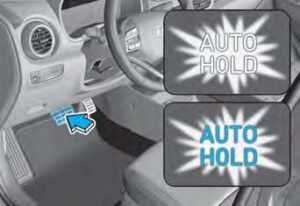
- When you stop the vehicle completely by depressing the brake pedal, the Auto Hold maintains the brake pressure to hold the vehicle stationary. The indicator changes from white to green.
- The vehicle will remain stationary even if you release the brake pedal.
- If EPB is applied, Auto Hold will be released.
To release:
If you depress the accelerator pedal with the shift lever in D (Drive) or Manual shift mode, the Auto Hold will be released automatically and the vehicle will start to move. The AUTO HOLD indicator changes from green to white.
WARNING
When the AUTO HOLD is automatically released by depressing the accelerator pedal, always take a look around your vehicle.
Slowly depress the accelerator pedal for a smooth start.
To cancel: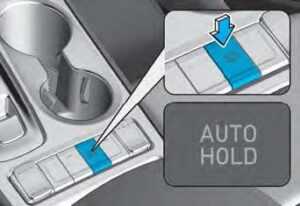
- Depress the brake pedal.
- Press the [AUTO HOLD] switch. The AUTO HOLD indicator will turn off.
WARNING
To prevent, unexpected and sudden vehicle movement, ALWAYS press your foot on the brake pedal to cancel the Auto Hold before you:
- Drive downhill.
- Drive the vehicle in R (Reverse).
- Park the vehicle.
Information
- The Auto Hold does not operate when:
- The driver’s door is opened.
- The hood is opened.
- The shift lever is in P (Park) or R (Reverse).
- EPB is applied.
- For your safety, the Auto Hold automatically switches to EPB when:
- The driver’s door is opened.
- The hood is opened.
- The vehicle is in a standstill for more than 10 minutes.
- The vehicle is standing on a steep slope.
- The vehicle moved several times.
- In these cases, the parking brake warning light comes on, the AUTO HOLD indicator changes from green to white, and a warning sound and a message will appear to inform you that EPB has been automatically engaged. Before driving off again, depress the brake pedal, check the surrounding area near your vehicle and release the parking brake manually with the EPB switch.
- While operating Auto Hold, you may hear a mechanical noise. However, it is normal operating noise.
NOTICE
If the AUTO HOLD indicator changes to yellow, the Auto Hold is not working properly. Contact an authorized HYUNDAI dealer.
WARNING
- Depress the accelerator pedal slowly when you start the vehicle.
- For your safety, cancel the Auto Hold when you drive downhill, back up the vehicle or park the vehicle.
NOTICE
If there is a malfunction with the driver’s door or hood open detection system, the Auto Hold may not work properly.
Contact an authorized HYUNDAI dealer.
Warning messages
 Parking brake automatically applied
Parking brake automatically applied
When the EPB is applied from Auto Hold, a warning will sound and a message will appear.  Deactivating AUTO HOLD…
Deactivating AUTO HOLD…
Press brake pedal
When the conversion from Auto Hold to EPB is not working properly a warning will sound and a message will appear.
When this message is displayed, the Auto Hold and EPB may not operate. For your safety, depress the brake pedal.  Press brake pedal to deactivate AUTO HOLD
Press brake pedal to deactivate AUTO HOLD
If you did not apply the brake pedal when you release the Auto Hold by pressing the [AUTO HOLD] switch, a warning will sound and a message will appear. 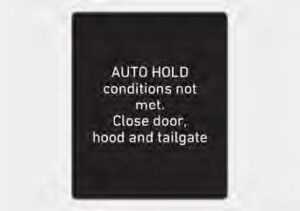 AUTO HOLD conditions not met. Close the door, hood, and liftgate
AUTO HOLD conditions not met. Close the door, hood, and liftgate
When you press the [AUTO HOLD] switch, if the driver’s door and hood are not closed, a warning will sound and a message will appear on the cluster LCD display.
Press the [AUTO HOLD] switch after closing the driver’s door and hood and liftgate.
Brake Disc Cleaning (If equipped)
Use the Brake Disc Cleaning function if noise is generated when depressing the brake while driving or if the brake disc gets rusty. It helps reduce noise and rust. Regenerative braking is restrained while Brake Disc Cleaning is operated, which may lower the electric energy efficiency.
Press and hold the AUTO HOLD button for over 3 seconds.
- Brake Disc Cleaning starts operating when the message ‘Brake disc cleaning’ is displayed on the instrument cluster.
- Regenerative braking is restrained while the brake is depressed approximately 10 times while driving (it may differ depending on driving conditions). It helps reduce noise and rust.
- The Brake Disc Cleaning function will turn off automatically when the operation is completed. It can also be turned off before the operation is completed by turning off the vehicle or pressing the AUTO HOLD button for over 3 seconds.
2023 Hyundai Elantra Specs, Price, Features, Milage (Brochure)
Anti-lock Brake System (ABS)
WARNING
Anti-Lock Braking System (ABS) or Electronic Stability Control (ESC) will not prevent accidents due to improper or dangerous driving manoeuvres. Even though vehicle control is improved during emergency braking, always maintain a safe distance between you and objects ahead of you. Vehicle speeds should always be reduced during extreme road conditions. The braking distance for vehicles equipped with ABS or ESC may be longer than for those without these systems in the following road conditions.
Drive your vehicle at reduced speeds during the following conditions:
- Rough, gravel or snow-covered roads.
- On roads where the road surface is pitted or has a different surface height.
- Tire chains are installed on your vehicle. Drive your vehicle at reduced speeds during the above conditions.
The safety features of ABS or ESC-equipped vehicle should not be tested by high-speed driving or cornering. This could endanger the safety of yourself or others.
ABS is an electronic braking system that helps to prevent a braking skid. ABS allows the driver to steer and brake at the same time.
Using ABS
To obtain the maximum benefit from your ABS in an emergency situation, do not attempt to modulate your brake pressure and do not try to pump your brakes. Depress your brake pedal as hard as possible. When you apply your brakes under conditions that may lock the wheels, you may hear sounds from the brakes, or feel a corresponding sensation in the brake pedal. This is normal and it means your ABS is active.
ABS does not reduce the time or distance it takes to stop the vehicle. Always maintain a safe distance from the vehicle in front of you. ABS will not prevent a skid that results from sudden changes in direction, such as trying to take a corner too fast or making a sudden lane change. Always drive at a safe speed depending on the road and weather conditions.
ABS cannot prevent a loss of stability. Always steer moderately when braking hard. Severe or sharp steering wheel movement can still cause your vehicle to veer into oncoming traffic or off the road.
On loose or uneven road surfaces, the operation of the anti-lock brake system may result in a longer stopping distance than for vehicles equipped with a conventional brake system.
The ABS warning light will stay on for several seconds after the START/STOP button is placed in the ON position. During that time, the ABS will go through self-diagnosis and the light will go off if everything is normal. If the light stays on, you may have a problem with your ABS. Contact an authorized HYUNDAI dealer as soon as possible.
WARNING
If the ABS warning light is on and stays on, you may have a problem with the ABS. Your power brakes will work normally. To reduce the risk of serious injury or death, contact your HYUNDAI dealer as soon as possible.
NOTICE
When you drive on a road having poor traction, such as an icy road, and apply your brakes continuously, ABS will be active continuously and the ABS warning light may illuminate.
Pull your vehicle over to a safe place and turn the vehicle off.
Restart the vehicle. If the ABS warning light is off, then your ABS system is normal.
Otherwise, you may have a problem with your ABS system. Contact an authorized HYUNDAI dealer as soon as possible.
Information
When you jump-start your vehicle because of a drained battery, the ABS warning light ( ) may turn on at the same time. This happens because of the low battery voltage. It does not mean your ABS is malfunctioning. Has the battery recharged before driving the vehicle?
Electronic Stability Control (ESC)
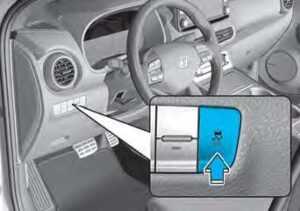 The Electronic Stability Control (ESC) system helps to stabilize the vehicle during cornering manoeuvres.
The Electronic Stability Control (ESC) system helps to stabilize the vehicle during cornering manoeuvres.
ESC checks where you are steering and where the vehicle is actually going. ESC applies braking pressure to any one of the vehicle’s brakes and intervenes in the electric vehicle control system to assist the driver with keeping the vehicle on the intended path. It is not a substitute for safe driving practices. Always adjust your speed and driving to the road conditions.
WARNING
Never drive too fast for the road conditions or too quickly when cornering. The ESC system will not prevent accidents.
Excessive speed in turns, abrupt manoeuvres, and hydroplaning on wet surfaces can result in severe accidents.
ESC operation
ESC ON condition
When the START/STOP button is in the ON position, ESC and the ESC OFF indicator lights illuminate for approximately three seconds and goes off, then ESC is turned on.
When operating
When ESC is in operation, the ESC indicator light blinks:
- When you apply your brakes under conditions which may lock the wheels, you may hear sounds from the brakes, or feel a corresponding sensation in the brake pedal. This is normal and it means your ESC is active.
- When ESC activates, the vehicle may not respond to the accelerator as it does under routine conditions.
- If Cruise Control was in use when ESC activates, Cruise Control automatically disengages. Cruise Control can be reengaged when the road conditions allow. See “Cruise Control System” later in this chapter 7. (if equipped)
ESC OFF condition
To cancel ESC operation:
- State 1
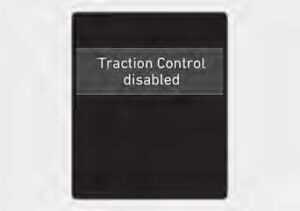 Press the ESC OFF button briefly. The ESC OFF indicator light and message “Traction Control disabled” will illuminate. In this state, the traction control function of ESC is disabled, but the brake control function of ESC (braking management) still operates.
Press the ESC OFF button briefly. The ESC OFF indicator light and message “Traction Control disabled” will illuminate. In this state, the traction control function of ESC is disabled, but the brake control function of ESC (braking management) still operates.
State 2
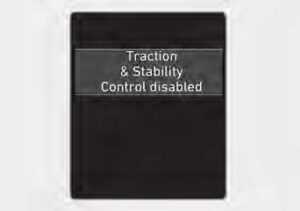 Press and hold the ESC OFF button continuously for more than 3 seconds. The ESC OFF indicator light and message “Traction & Stability Control disabled” illuminates and a warning chime sounds. In this state, both the traction control function of ESC and the brake control function of ESC are disabled.
Press and hold the ESC OFF button continuously for more than 3 seconds. The ESC OFF indicator light and message “Traction & Stability Control disabled” illuminates and a warning chime sounds. In this state, both the traction control function of ESC and the brake control function of ESC are disabled.
If the START/STOP button is placed in the LOCK/OFF position when ESC is off, ESC remains off. Upon restarting the vehicle, the ESC will automatically turn on again.
Indicator lights  When the START/STOP button is in the ON position, the ESC indicator light illuminates, then goes off if ESC is operating normally.
When the START/STOP button is in the ON position, the ESC indicator light illuminates, then goes off if ESC is operating normally.
The ESC indicator light blinks whenever ESC is operating.
If the ESC indicator light stays on, your vehicle may have a malfunction with the ESC system. When this warning light illuminates, have the vehicle checked by an authorized HYUNDAI dealer as soon as possible.
The ESC OFF indicator light comes on when ESC is turned off with the button.
WARNING
When ESC is blinking, this indicates ESC is active:
Drive slowly and NEVER attempt to accelerate. NEVER turn ESC off while the ESC indicator light is blinking or you may lose control of the vehicle resulting in an accident.
NOTICE
Driving with wheels and tires with different sizes may cause ESC to malfunction. Before replacing tires, make sure all four tires and wheels are the same size. Never drive the vehicle with different sized wheels and tires installed.
ESC OFF usage
When Driving
The ESC OFF mode should only be used briefly to help free the vehicle if stuck in snow or mud, by temporarily stopping operation of ESC, to maintain wheel torque.
To turn ESC off while driving, press the ESC OFF button while driving on a flat road surface.
NOTICE
- Do not allow wheel(s) of one axle to spin excessively while the ESC, ABS, and parking brake warning lights are displayed. The repairs would not be covered by the vehicle warranty. Reduce vehicle power and do not spin the wheel(s) excessively while these lights are displayed.
- When operating the vehicle on a dynamometer, make sure ESC is turned off (ESC OFF light illuminated).
Information
Turning ESC off does not affect ABS or standard brake system operation.
Vehicle Stability Management (VSM)
Vehicle Stability Management (VSM) is a function of the Electronic Stability Control (ESC). It helps ensure the vehicle stays stable when accelerating or braking suddenly on wet, slippery and rough roads where traction over the four tires can suddenly become uneven.
WARNING
Take the following precautions when using Vehicle Stability Management (VSM):
- ALWAYS check the speed and the distance to the vehicle ahead. VSM is not a substitute for safe driving practices.
- Never drive too fast for the road conditions. VSM will not prevent accidents. Excessive speed in bad weather, on slippery and uneven roads can result in severe accidents.
VSM operation
VSM ON condition
VSM operates when:
- Electronic Stability Control (ESC) is on.
- Vehicle speed is approximately under 93 mph (150 km/h) when the vehicle is braking on rough roads.
When operating
When you apply your brakes under conditions which may activate ESC, you may hear sounds from the brakes, or feel a corresponding sensation in the brake pedal. This is normal and it means your VSM is active.
Information
VSM does not operate when:
- Driving on a banked road such as gradient or incline.
- Driving in reverse.
- The ESC OFF indicator light is on.
- The EPS (Electric power steering) warning light ) is on or blinks.
WARNING
If the ESC indicator light ( ) or EPS warning light ( ) stays illuminated or blinks, your vehicle may have a malfunction with VSM. When the warning light illuminates, have the vehicle checked by an authorized HYUNDAI dealer as soon as possible.
NOTICE
Driving with wheels and tires with different sizes may cause VSM to malfunction. Before replacing tires, make sure all four tires and wheels are the same size. Never drive the vehicle with different-sized tires and wheels installed.
Hill-Start Assist Control (HAC)
Hill-Start Assist Control (HAC) helps prevent the vehicle from rolling backwards when starting a vehicle from a stop on a hill. The system operates the brakes automatically for approximately 3 seconds and releases the brake after 3 seconds or when the accelerator pedal is depressed.
WARNING
Always be ready to depress the accelerator pedal when starting off on an incline. The HAC activates only for approximately 5 seconds.
Information
- HAC does not operate when the shift lever is in P (Park) or N (Neutral).
- HAC activates even when ESC (Electronic Stability Control) is off. However, it does not activate, when ESC does not operate normally.
Good Braking Practices
WARNING
Whenever leaving the vehicle or parking, always come to a complete stop and continue to depress the brake pedal. Move the shift lever into the P
(Park) position, then apply the parking brake, and place the START/STOP button in the LOCK/OFF position.
Vehicles parked with the parking brake not applied or not fully engaged may roll inadvertently and may cause injury to the driver and others. ALWAYS apply the parking brake before exiting the vehicle.
Wet brakes can be dangerous! The brakes may get wet if the vehicle is driven through standing water or if it
is washed. Your vehicle will not stop as quickly if the brakes are wet. Wet brakes may cause the vehicle to pull to one side.
To dry the brakes, apply the brakes lightly until the braking action returns to normal, taking care to keep the vehicle under control at all times. If
the braking action does not return to normal, stop as soon as it is safe to do so. Call an authorized HYUNDAI dealer for assistance.
DO NOT drive with your foot resting on the brake pedal. Even light, but constant pedal pressure can result in the brakes overheating, brake wear, and possibly even brake failure.
If a tire goes flat while you are driving, apply the brakes gently and keep the vehicle pointed straight ahead while you slow down. When you are moving slowly enough for it to be safe to do so, pull off the road and stop in a safe location.
Keep your foot firmly on the brake pedal when the vehicle is stopped to prevent the vehicle from rolling forward.
FAQ
A: The 2023 Hyundai Kona EV typically uses a regenerative braking system combined with traditional friction brakes.
A: Regenerative braking captures and converts kinetic energy back into electrical energy when you lift off the accelerator, which helps recharge the vehicle’s battery.
A: Yes, the regenerative braking intensity in the Kona EV is often adjustable through various driving modes, allowing the driver to choose the level of regen braking they prefer.
A: Yes, with the regenerative braking system, the Kona EV allows for one-pedal driving, where you can accelerate and decelerate using only the accelerator pedal in many situations.
A: The Kona EV typically comes equipped with advanced safety features like automatic emergency braking and pedestrian detection to enhance braking safety.
A: The frequency of brake pad replacement can vary depending on driving habits and conditions, but regenerative braking often reduces wear on traditional brake pads, potentially extending their lifespan.
A: The Kona EV uses both regenerative and hydraulic brakes. Regenerative braking is primarily used for energy recovery, and hydraulic brakes are used for more substantial deceleration and stopping.
A: The size of the brake discs can vary depending on the specific trim and options, so it’s best to check the vehicle’s specifications for precise details.
A: Yes, the Kona EV typically features a brake assist system that can provide additional braking force during emergency stops.
A: Yes, the Kona EV is typically equipped with an anti-lock braking system (ABS) to prevent wheel lockup during hard braking, enhancing control.
A: While the regenerative braking system reduces wear on traditional brakes, it’s essential to follow Hyundai’s recommended maintenance schedule, including regular brake fluid checks and replacements.
A: Yes, many Kona EV models offer adjustable regenerative braking settings that allow you to customize the driving experience according to your preferences.
A: Regenerative braking can extend the range of the Kona EV by capturing and reusing energy during deceleration and braking, which helps recharge the battery.
A: Specific issues or recalls can vary by region and production batch. It’s advisable to check with your local Hyundai dealership or visit Hyundai’s official website for the latest information on recalls or service bulletins related to the braking system.
A: Yes, the Kona EV typically comes with an electronic parking brake that is easy to engage and disengage for added convenience.
Useful Link
View Full User Guide: Hyundai Kona-EV 2023 User Guide
Hyundai Kona-EV 2023 Driver Attention Warning (DAW) User Guide
2023 Hyundai Elantra Specs, Price, Features, Milage (Brochure)

